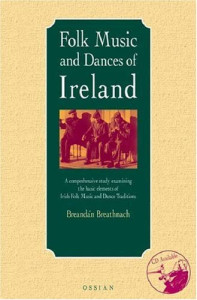 Laurie Thayer wrote this review.
Laurie Thayer wrote this review.
The author of this book is, according to the cover blurb, “one of the foremost authorities on the traditional music of Ireland,” and he certainly lives up to that reputation. In the first few pages of his study, he defines folk music as music that, while it may have been originally composed by a single person, has been accepted into the community and passed from generation to generation, each succeeding player changing the tune to suit him or herself. He later states that such music is only traditional as long as it is played or sung by a solo performer and that music is no longer traditional when performed by an ensemble.
This book is an amazingly detailed study of every aspect of Irish traditional music. Breathnach first takes a look at the keys in which such music is set, then moves on to discuss the history and types of songs.
The next section discusses types and rhythms of traditional dances and how they are performed, right down to the footwork. He gives us a fascinating chapter on the history of dancing masters, itinerant teachers who taught local children the intricacies of traditional dance. He then examines the types of dance music, differentiating between jigs, hornpipes and reels.
This discussion is followed by a study of the main instruments of traditional music, including the pipes, the harp, the flute and whistles, and the melodeon. He goes into detail about how the instruments are made and even gives fingering charts for pipes and tin whistles. A look at the techniques and styles of traditional playing follows, with a detailed discussion of musical ornamentation and how it varies in different parts of Ireland. This is followed by a short history of the men who have collected and preserved traditional music.
Included at the end of the book are several appendices, the most notable of which is the first, in which thirty traditional tunes are presented with music and lyrics. The foreword of the book states that these songs are available in recorded form so that the reader may become familiar with traditional music played in an “authentic manner.”
Breathnach obviously has a passion for traditional music and is doing his best to convey that passion to his readers. His book, however, is dust-dry and so technical that you practically need a degree in music to understand some sections of it.
He takes for granted that his readers will be able to read both music and Irish Gaelic; many examples are given using musical notation, and there are numerous untranslated Gaelic phrases and one notable passage where he uses several untranslated paragraphs as an example of richly symbolic metaphor. Granted, the translations do appear in an appendix at the end of the book, but it would be preferable to see them in the text, where the reader does not have to search for them.
This book is not recommended for the newcomer to the field of Irish traditional music; novices would find it extremely intimidating. Experts, on the other hand, would probably find the wealth of information included herein very helpful.
(Mercier Press, 1971, reprinted in 1993)
If you are interested in Irish music, check out our reviews of the following books: Notes From the Heart: A Celebration of Irish Music; A Pocket History of Irish Traditional Music; and Tunes of the Munster Pipers: Irish Traditional Music from the James Goodman Manuscripts.
